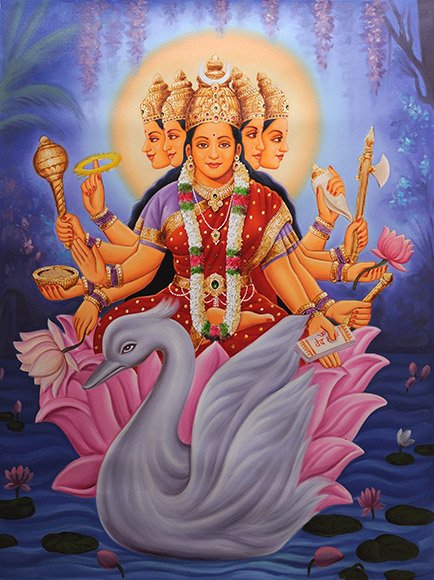Rupagosvamin, Rūpagosvāmin, Rupa-gosvamin: 5 definitions
Introduction:
Rupagosvamin means something in Hinduism, Sanskrit. If you want to know the exact meaning, history, etymology or English translation of this term then check out the descriptions on this page. Add your comment or reference to a book if you want to contribute to this summary article.
In Hinduism
Chandas (prosody, study of Sanskrit metres)
Source: Shodhganga: a concise history of Sanskrit Chanda literatureRūpagosvāmin (रूपगोस्वामिन्) (C. 1470-1583 C.E.), author of Aṣṭādaśachandas and erudite scholar of Indian Diaspora, has enriched the Sanskrit literature by his various compositions with the nectar of Vaiṣṇava philosophy. He popularized the Sanskrit learning among Vaiṣṇavites and educated his disciples. He has composed works, which speak both the Vaiṣṇava philosophy and the essence of Sanskrit. He is the one who carried forward the legacy of prema-bhakti interpreted by Caitanya (1486- 1533 C.E.). He interpreted the bhakti as a rasa in his Ujjvalanīlamaṇi. Before him, the bhakti was counted as among śānta-rasa.
Rūpagosvāmin was born in a Brahmin family of Gauḍa (now Bengal). His family originally hails from Karṇāṭaka and migrated to the then princely state of Gauḍa. His sixth ancestor Aniruddha was a king of Karṇāṭaka in about Śaka 1338. Rūpagosvāmin was the son of Kumāra, grandson of Mukunda, great grandson of Padmanābha and great great grandson of Rūpeśvara, who is the son of Jagadguru Niruddha. He had two brothers namely Vallabha and Sanātana. He was also the uncle of Jīvagosvāmin, son of his younger brother Vallabha. He was a resident of Rāmakeli, a village in Bengal.
Rūpagosvāmin was devoted towards Vaiṣṇava philosophy after he met Caitanya and was respected as one of the six Gosvāmins of Vṛndāvan subsequently.

Chandas (छन्दस्) refers to Sanskrit prosody and represents one of the six Vedangas (auxiliary disciplines belonging to the study of the Vedas). The science of prosody (chandas-shastra) focusses on the study of the poetic meters such as the commonly known twenty-six metres mentioned by Pingalas.
Languages of India and abroad
Sanskrit dictionary
Source: Cologne Digital Sanskrit Dictionaries: Aufrecht Catalogus CatalogorumRūpagosvāmin (रूपगोस्वामिन्) as mentioned in Aufrecht’s Catalogus Catalogorum:—Keśavāṣṭaka. Mathurāmāhātmya. Saṃkṣepabhāgavatāmṛta. Sādhanāmṛta. Stavamālā, composed in 1550. Catal. Io. No. 3943. Smaraṇamaṅgalaikadaśaka.
Source: Cologne Digital Sanskrit Dictionaries: Monier-Williams Sanskrit-English DictionaryRūpagosvāmin (रूपगोस्वामिन्):—[=rūpa-go-svāmin] [from rūpa > rūp] m. Name of an author, [Catalogue(s)]
[Sanskrit to German]
Sanskrit, also spelled संस्कृतम् (saṃskṛtam), is an ancient language of India commonly seen as the grandmother of the Indo-European language family (even English!). Closely allied with Prakrit and Pali, Sanskrit is more exhaustive in both grammar and terms and has the most extensive collection of literature in the world, greatly surpassing its sister-languages Greek and Latin.
See also (Relevant definitions)
Partial matches: Gosvamin, Rupa, Svamin.
Full-text (+102): Hamsaduta, Chandoshtadashaka, Utkalikavallari, Vrajavilasastava, Danakelikaumudi, Natakacandrika, Caitanyashtaka, Harekrishnamahamantrarthanirupana, Premendusagara, Lalitamadhava, Rupagosvamigunaleshasucakanamadashaka, Vidagdhamadhava, Upadeshamrita, Keshavashtaka, Paramarthasamdarbha, Rasamritashesha, Mathuramahiman, Ujjvalanilamani, Samkshepamrita, Pritisamdarbha.
Relevant text
Search found 2 books and stories containing Rupagosvamin, Rūpagosvāmin, Rupa-gosvamin, Rūpa-gosvāmin, Rupago-svamin, Rūpago-svāmin; (plurals include: Rupagosvamins, Rūpagosvāmins, gosvamins, gosvāmins, svamins, svāmins). You can also click to the full overview containing English textual excerpts. Below are direct links for the most relevant articles:
Vasudevavijaya of Vasudeva (Study) (by Sajitha. A)
The concept of Bhakti in Vāsudevavijaya < [Chapter 5 - Impact of other Disciplines in Vāsudevavijaya]
Kuntaka’s evaluation of Sanskrit literature (by Nikitha. M)
5. Subhāṣitaratnakośa in Kuntaka’s treatment < [Chapter 6 - Kuntaka’s assessment of Verses Cited in Śatakas and Anthologies]